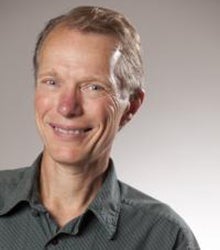
Bart Johnson
BS, 1987, Cornell; MLA, 1992, PhD, 1995, Georgia. (1995)
Dr. Bart Johnson is a Professor in the Department of Landscape Architecture at the University of Oregon. His academic training in agronomy (BS), landscape architecture (MLA) and ecology (PhD) reflect his lifelong passion for learning how to integrate people and their use of the land with native ecosystems and evolutionary processes. Both his teaching and research focus on the integration of ecology into landscape design, planning and management, with a particular emphasis on conservation planning and ecological restoration through the linkage of innovative design with rigorous research. This includes applying the conceptual frameworks and analytical techniques of ecology toward design and planning, as well as using the cultural knowledge and approaches of landscape architecture to deepen knowledge of how humans structure ecosystems.
His research is collaborative and interdisciplinary. Current projects focus on the interactions and feedbacks among climate change, wildfire, urbanization, rural settlement, endangered ecosystems and land management. The work integrates techniques and approaches from participatory planning, simulation modeling, manipulative experiments, prescribed fire, and historical vegetation reconstruction. The ecological context of these studies centers on Pacific Northwest oak savanna, upland prairie and wetland prairie, all imperiled ecosystems.
In addition to landscape design and planning studios, his courses include Principles of Applied Ecology, Climate Change Planning and Design, Landscape Research II, and two intensive field courses, Fire as a Tool for Landscape Design and Management and Reading the Landscape of the High Cascades.
Dr. Johnson is the UO and international steering committee chair for the Sustainable Cities and Landscapes Hub (https://apru-scl.uoregon.edu/), an international consortium of 12 universities led by the UO under the auspices of the Association of Pacific Rim Universities (APRU). He was the lead editor of the 2002 book Ecology and Design: Frameworks for Learning, that brought together landscape architects and ecologists to build bridges between the two disciplines. He also was the University of Oregon lead for an international consortium on urban ecology education and has taught ecological design at Tsinghua University in Beijing, China.
He is the recipient of three recent grants from the National Science Foundation and the U.S. Department of Energy for collaborative, interdisciplinary research on the implications of climate change for biodiversity and landscape planning in the Pacific Northwest.
Selected Recent Publications
Mhuireach, G. Á., B. R. Johnson, A. E. Altrichter, J. Ladau, J. F. Meadow and J. L. Green. 2016. Urban greenness influences airborne bacterial community composition. Science of the Total Environment 571: 680–687. http://dx.doi.org/10.1016/j.scitotenv.2016.07.037.
Roos, C. I, A. C. Scott, C. M. Belcher, W. G. Chaloner, J. Aylen, R. Bliege Bird, M. R. Coughlan, B. R. Johnson, F. H. Johnston, J. McMorrow, T. Steelman, and the Fire and Mankind Discussion Group. 2016. Living on a flammable planet: interdisciplinary, cross-scalar, and varied cultural lessons, prospects, and challenges. Phil. Trans. R. Soc. B 371:20150469. http://dx.doi.org/10.1098/rstb.2015.0469.
Fischer, P. A., T. A. Spies, T. A. Steelman, C. Moseley, B. R. Johnson, J. D. Bailey, A. A. Ager, P. Bourgeron, S. Charnley, B. M. Collins, J. D. Kline, J. E. Leahy, J. S. Littell, J. D. A. Millington, M. Nielsen-Pincus, C. S. Olsen, T. B. Paveglio, C. I. Roos, M. M. Steen-Adams, F.R. Stevens, J. Vukomanovic, E. M. White, and D. M. J. S. Bowman. 2016. Wildfire risk as a socio-ecological pathology. Frontiers in Ecology and the Environment 14(5): 276–284. http://dx.doi.org/10.1002/fee.1283.
Hulse, D., A. Branscomb, C. Enright, B. Johnson, C. Evers and J. Bolte. 2016. Anticipating Surprise: using agent-based alternative futures simulation modeling to identify and map surprising fires in the Willamette Valley, Oregon U.S.A. Landscape and Urban Planning. http://dx.doi.org/10.1016/j.landurbplan.2016.05.012.
Pfeifer-Meister, L., S. D. Bridgham, L. L. Reynolds, M. E. Goklany, H. E. Wilson, C. J. Little, A. Ferguson, and B. R. Johnson. 2016. Climate change alters plant biogeography in Mediterranean prairies along the West Coast, USA. Global Change Biology. 22(2): 845–855. http://dx.doi.org/10.1111/gcb.13052.
Wu, H., D. Hulse, J. Bolte and B. R. Johnson. 2015. A scenario-based approach to integrating flow-ecology research with watershed development planning. Landscape and Urban Planning 144: 74–89. http://dx.doi.org/10.1016/j.landurbplan.2015.08.012.
Reynolds, L. L., B. R. Johnson, L. Pfeifer-Meister, and S. D. Bridgham. 2015. Soil respiration response to climate change in Pacific Northwest prairies is mediated by a regional Mediterranean climate gradient. Global Change Biology 21(1): 487–500. http://dx.doi.org/10.1111/gcb.12732.
Nielsen-Pincus, M., R. G. Ribe, and B. R. Johnson. 2015. Spatially and socially segmenting private landowner motivations, properties, and management: A typology for the wildland urban interface. Landscape and Urban Planning 137: 1-12. http://dx.doi.org/10.1016/j.landurbplan.2014.11.020.
Yospin, G. I., S. D. Bridgham, R. P. Neilson, J. P. Bolte, D. M. Bachelet, P. J. Gould, C. A. Harrington, J. A. Kertis, C. Evers, and B. R. Johnson. 2015. A new model to simulate climate change impacts on forest succession for local land management. Ecological Applications 25(1): 226–242. http://dx.doi.org/10.1890/13-0906.1.
Pfeifer-Meister, L., S. D. Bridgham, T. Tomaszewski, C. J. Little, L. L. Reynolds, M. E. Goklany and B. R. Johnson. 2013. Pushing the limit: experimental evidence of climate effects on plant range distributions. Ecology 94(10): 2131–2137. http://dx.doi.org/10.1890/13-0284.1.
Pfeifer-Meister, L., B. R. Johnson, B. A. Roy, S. Carreño, J. L. Stewart, and S. D. Bridgham. 2012. Restoring wetland prairies: tradeoffs among native plant cover, community composition, and ecosystem functioning. Ecosphere 3(12): 1–19. http://dx.doi.org/10.1890/ES12-00261.1.
Pfeifer-Meister, L., B. A. Roy, B. R. Johnson, J. Krueger, and S. D. Bridgham. 2012. Dominance of native grasses leads to community convergence in wetland restoration. Plant Ecology 213(4): 637-647. doi:10.1007/s11258-012-0028-2.
Bachelet, D., B. R. Johnson, S. D. Bridgham, P. V. Dunn, H. E. Anderson and B. M. Rogers. 2011. Climate Change Impacts on Western Pacific Northwest Prairies and Savannas. Northwest Science: 85 (2): 411-429. https://doi.org/10.3955/046.085.0224.
